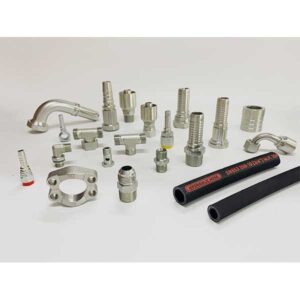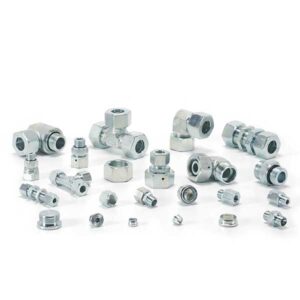Hydraulic hose fittings are components in any hydraulic system, responsible for ensuring leak-free connections between hoses, pipes, and fittings. These fittings come in a wide range of sizes and types, each designed for specific applications and pressure ratings.

Choosing the right hydraulic hose fittings is important for a reliable and efficient hydraulic system. Understanding the hydraulic hose connectors types, their materials, and compatibility factors can save you time and prevent potential problems.
This guide will help you understand hydraulic hose fittings and make informed decisions when selecting, installing, and maintaining these components.
What are hydraulic hose fittings?

Hydraulic hose connectors play a vital role in joining hydraulic hoses to pipe, equipment, and other hoses, enabling quick connection and disconnection without the use of tools. They allow fluid to flow smoothly throughout the system, enabling it to function optimally. They also seal and protect hose ends from contaminants such as dust and dirt.
These fittings are designed in various shapes and sizes to withstand high pressure and temperature fluctuations. Different types of hydraulic hose couplings include elbows, straight, tees, and cross fittings, each playing a unique role in the system.
What materials are hydraulic hose fittings made of?
The materials used in hydraulic hose fittings affect their performance and durability. Steel, stainless steel, and brass are the most commonly used materials because they offer varying degrees of durability, corrosion resistance, heat tolerance, and light-weight properties with a wide range of fluids.
Stainless steel hose fittings offer excellent corrosion resistance, making them ideal for harsh environments.
Brass, on the other hand, boasts high strength, corrosion resistance, and high-temperature resistance, making it a popular choice for general applications.
Steel connectors offer remarkable corrosion resistance, high strength, and durability, and can withstand high pressure and high temperatures, making them suitable for a wide range of hydraulic applications.
Types of hydraulic hose fittings
A wide array of hydraulic hose connectors is available to suit various applications, including metal seal connectors, soft seal connectors, tapered thread connectors, O-Ring fittings, and face-seal (flat-face) O-Ring fittings.
Some common types of connectors include crimped and push-lock connectors, each offering its own set of advantages and applications.
Crimped connectors are permanently sealed onto a hydraulic hose using a crimping machine, providing a dependable and leak-proof connection.
Push-lock connectors are field attachable and enable the swift and effortless assembly of hydraulic hoses without the need for clamps or crimp sleeves.
How to Identify Hydraulic Hose Fittings
Identifying hydraulic hose fittings can be a daunting task, especially given the wide variety of types and sizes available. Here are some key factors to consider:
Check the connection type—is it male or female, and a straight, elbow, or tee?
Measure the hose fitting dimensions—this will help ensure an accurate fit to the hydraulic system.
Match the port connection to the hose connection—consider the thread size, which should correspond to the port size to ensure a secure and leak-free connection.
How to Size Hydraulic Hose Fittings
Size is of paramount importance when choosing the end fittings for a hydraulic hose. The fitting size must correspond to the inner diameter and outer diameter of the hose to ensure a secure and tight connection. Incorrect size can lead to leakage, reduced operational efficiency, and potential damage to the hydraulic system. Therefore, accurate measurement and selection of fitting size are important for maintaining the performance and longevity of the hydraulic system.
Choose the right fittings for your hydraulic hose
The selection of a hydraulic hose connector requires consideration of compatibility with the hose type, pressure rating, and overall performance.
A fitting that is both suitable for the hose material and fluid, and consistent in size with the hose, aids in preventing leaks and system malfunctions. Hydraulic hose fittings play a big role the performance of the system.
Factors such as pressure rating, material, diameter, thread/connection type, size, temperature rating, flow rate, and hose compatibility must be considered with the compatibility of hydraulic hose connectors.
Mismatched hydraulic hose connectors can have a detrimental effect on the performance of the hydraulic system, including leaks and bursts, pressure losses, improper flow, and incompatibility.
Considering the application is essential, as the type of fitting chosen must suit the specific demands of the hydraulic system, whether it’s a mobile hydraulic application with dynamic working conditions or a stationary one with constant conditions.
The temperature of the hydraulic system and the surrounding environment should also be factored in, as it can significantly impact the performance and lifespan of the fitting.
Size is of paramount importance when choosing the end fittings for a hydraulic hose. The fitting size must correspond to the inner diameter and outer diameter of the hose to ensure a secure and tight connection. Incorrect size can lead to leakage, reduced operational efficiency, and potential damage to the hydraulic system. Therefore, accurate measurement and selection of fitting size are important for maintaining the performance and longevity of the hydraulic system.
The material of the fitting is another critical factor to consider as it must be compatible with the hydraulic fluid used and capable of withstanding operational pressures and environmental conditions.
The pressure capacity of the fitting must align with the maximum operating pressure of the hydraulic system, ensuring optimal performance and safeguarding against failures or leaks.
can hydraulic fittings be reused
it depends on the type of fitting; reusable fittings like those with NPT, JIC, or ORFS threads can be reused if they are in good condition, while permanent crimped fittings are designed for single use and must not be reused.
how to connect hydraulic hose fittings
First, ensure the tubing is clean and pressure has been released. Then, for quick-connect fittings, push the male and female fittings into place until locked, rotating the retaining ring if necessary to align with the release mechanism. For permanent connections, use hydraulic crimping pliers to press the retaining ring of the fitting onto the hose, thus permanently securing the fitting to the hose.
how are hydraulic hose fittings measured
When measuring hydraulic hose fittings, the main requirements are the thread size, fitting type, and hose assembly angle. You can use a thread gauge or calipers to measure the total thread diameter and pitch to determine whether it's a metric or imperial standard. Additionally, you need to know the fitting type (e.g., JIC or BSP), and when measuring elbows, the hose should be straightened, and the included angle between the two elbows should be measured.
why hydraulic hose fittings leaking
Hydraulic hose fittings may leak due to: aging, damage, or improper installation of seals (such as O-rings); loose fittings or incorrect installation; or physical damage to the hose or fitting. Other causes include excessive system pressure, abnormal temperature, contaminated hydraulic fluid, or excessive vibration.
how to put fittings on hydraulic hose
You can connect hydraulic hoses in several ways, such as threaded, crimped, flanged, and quick-connect. Each method requires a different type of hydraulic hose fitting. However, their primary goal is to ensure the connection is leak-free and reliable. Therefore, you can use your system safely.
how to replace hydraulic hose fittings
In conclusion, choosing the right hydraulic hose fittings is crucial for ensuring the optimal performance and extended lifespan of a hydraulic system. Understanding the types, materials, compatibility, and best installation and maintenance practices of various fittings will help you make the right choice for your specific application.
If you have any hydraulic problems, please contact Sinopulse!